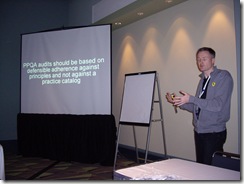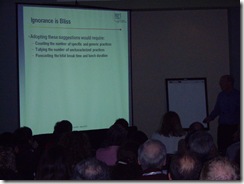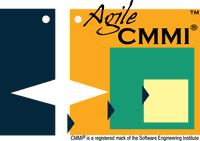SEPG North America – Day 1
Posted by agilecmmi on Mar 23, 2010 in Bottleneck, Cumulative Flow, David Anderson, High Maturity, Judah Mogilensky, Pat O'Toole, Performance, behavior | 1 comment
With yesterday being the "tutorial day" ahead of the conference, today was the official kick-off day of the conference sessions.
Morning started off in a laid-back way. Even better than sleeping until 7am was having breakfast with Pat O’Toole, Just a never-ending fount of wisdom and experience. Truly, if I ever needed an injection of fresh ideas for my practice, I’d start with him. We are all blessed with different advantages, one (or two?) of Pat’s is having two brothers who are both behavioral psychologists from whom he siphons oodles (technical term) of techniques.
 After missing the plenary sessions, my first attended session was David Anderson’s CMMI Through a Lean Lens. Excellent stuff! What I enjoyed most about it was how easily and convincingly one can see the benefits and accessibility of high maturity behavior with very little data and no artificial, convoluted process models. Nothing more than a few simple development "states" and a calendar. The richness of something as simple as a cumulative flow diagram was very well presented and, I believe, quickly grasped by the audience.
After missing the plenary sessions, my first attended session was David Anderson’s CMMI Through a Lean Lens. Excellent stuff! What I enjoyed most about it was how easily and convincingly one can see the benefits and accessibility of high maturity behavior with very little data and no artificial, convoluted process models. Nothing more than a few simple development "states" and a calendar. The richness of something as simple as a cumulative flow diagram was very well presented and, I believe, quickly grasped by the audience.
David had some suggestions for CMMI v2.0 to accommodate "continuous flow" instead of "transactional processes". He also suggested that continuous flow lent itself more to perceiving development as a service rather than a discrete project effort. It was very telling (to me) how eager the audience is growing over just a couple of years for this sort of data that they were raptly engaged in David’s content and seemed unconcerned for over-staying the room’s allocated time for his talk.
Next up was Judah Mogilensky’s proposal for a new CMMI process area called Fantasy Development. He started out with a brief overview of an earlier proposed process area, Blame Allocation, which has strong strategic ties to the Fantasy Development process area. Of many, one priceless anecdote was, "What’s with all this stuff about managing requirements and planning, and measuring progress? Why can’t CMMI have anything in it that we actually do?!?!"
Sadly, he’s not joking. He’s heard this before as have I. Not realizing what they’re admitting, people who don’t understand CMMI are missing the connection between CMMI and their real work. Unfortunately, whether they admit it or not, many organizations have very well-established and highly productive processes for allocating blame and developing fantasies for which Judah’s proposed PAs are meant to help improve.
As with earlier incarnations of these proposals, Judah made an important point: any area of work important to an organization can be improved with and measured against improvement practices and goals of their own creation. Nothing says CMMI must be the only source of improvement ideas.
Since he would be leaving later in the day, I spent a while after lunch with David to discuss ideas on lean and CMMI. It’s becoming clear that the world cannot wait for SEI or annual LSSC events to bring these topics together. There’s just too much synergy, both in terms of maturing organizational processes (from both a CMMI and non-CMMI perspective) and in terms of affecting culture and behavior that enables and promotes the quantification of these improvements.
Something I observed on the Savannah River on my way back to my hotel was blissfully (in a geeky way) appropriate for discussing continuous flow with David. (Watch the video if you’re interested in that.) He came to the same conclusion as I did, and, it was exactly what the deck hand on the ferry said happens in such situations.
David and I went to see Pat O’Toole’s session on "Maturity Level 4 Results in a Lot of BS." Never at a loss for a compelling title, Pat’s topic had to do with behavior, not what you might think. His example walked through 10 behaviors of high maturity teams that were exhibited by an appraisal team by the mere tracking and projecting of time during a particular appraisal task near the end of an appraisal. His example (masterfully, of course) demonstrated simple measurement and analysis traits with profound effects on both performance and behavior while they were being tabulated in real time. It was like watching magic. Not in the "unbelievable" sense, but in the "pure beauty of simplicity" sense. David and I made quick note that Pat would be a must in any sort of Lean-CMMI event.
His example walked through 10 behaviors of high maturity teams that were exhibited by an appraisal team by the mere tracking and projecting of time during a particular appraisal task near the end of an appraisal. His example (masterfully, of course) demonstrated simple measurement and analysis traits with profound effects on both performance and behavior while they were being tabulated in real time. It was like watching magic. Not in the "unbelievable" sense, but in the "pure beauty of simplicity" sense. David and I made quick note that Pat would be a must in any sort of Lean-CMMI event.
The conference gala reception ended the official activities. The simple movie-theater theme included rooms where two modern films shot in Savannah were playing: Forrest Gump, and Midnight in the Garden of Good and Evil, and a movie-style.concession stand full of popcorn, candy bars, nachos & cheese and Cracker Jack.
Not all rosy
Although I led the reviewer group for agile content for this year’s conference, I was not able to commit to attending all the agile-related presentations. So I am making it a point to query people attending these sessions for their immediate reactions. Reports from several people about presentations and tutorial content on "agile" topics is revealing a disappointing condition. Namely, that the "dark side" of the force is still strong in much of the content people are communicating. Several manifestations are cropping up including poor understanding of true "agility" and "lean" concepts and practices, re-purposing traditional approaches but calling them "agile" or "lean" by merely eliminating the obvious waste, and diluting the benefits of CMMI to enable achievement of ratings by teams using agile.
What’s most disappointing is that this content is supposedly the "best" of the crop of submitted abstracts which tells me that we need a better topic submission and review process. Namely, that what we ask for when proposing topics needs to be improved, and, how we review the proposals needs to be changed. A few years ago, the conference committee attempted an overall broad-based improvement for similar reasons but only came up with increasing the word-count on abstracts and asking for "take-aways" for each proposal. I guess this falls under the category of, "just because a little isn’t good, doesn’t mean more is better."
We need a better process. I’ll be providing that feedback at tomorrow’s conference retrospective.
Day’s Conclusion
One thing was abundantly clear from today: I was being given glimpses of the same idea over and over from many facets. That idea was about behavior. Behavior is central to improvement. End of discussion.
Culture will follow behavior, whether good or bad. People’s responses to input will be manifested in their behavior and that will be in response to the stimulus. I’ve known the central criticality of behavior in the continuum of improvement. However, the key "nugget" for me today was that it’s surprisingly simple to influence behavior in positive, productive, value-added ways. And, it’s also not as hard as we might think to turn "bad" behavior around with similarly simple, yet powerful examples of the benefits we want when we conduct ourselves with the behaviors that achieve them.
My conversation with Pat at breakfast, David’s cumulative flow diagram, Judah’s tongue-in-cheek process areas, the port’s fast clearing of their container backlog, Pat’s "BS" presentation, and other side-conversations I won’t detail here, all orbited on this one theme: behavior and how we affect it is the future of business performance improvement and we’d better get on that ferry right now.
SEPG North America – Tutorial Day
Posted by agilecmmi on Mar 22, 2010 in Appraisal, Collaboration, Conference, David Anderson, Efficiency, Jeff Dalton, Judah Mogilensky, LSSC, Michele Moss, Process Improvement, SEI, SEI Partner, SEPG, SEPG Conference, Speaking, Training, value, waste | 1 comment
So today started out with a bus ride from the hotel to the Savannah International Trade and Convention Center rather than the expected ferry ride over the river. A container ship in the port managed to get damaged and leaked fuel into the Savannah River on Sunday immediately closing the river to non-clean-up traffic, including the otherwise convenient cross-river ferry.
Be that as it may, the bus ride gave me an opportunity to connect with Michele Moss from Booz-Allen, Hamilton. A kindred spirit in things related to "the future of process". She and I had plans to meet anyway some time today to discuss ideas about "bringing ‘younger people’ into the field" and a related topic, addressing modern-day issues such as cyber, agile and value as these concerns are manifested in processes and process improvement.
First order of the day after registration was to co-create what I perceived as a rather successful (and well-attended) tutorial with Judah Mogilensky on a tailoring for SCAMPI appraisals that increases efficiency, collaboration, and reduces time and cost, we called "One-Stop Shopping". Immediately following, Michele and I met with Bob Rosenstein, the events and conferences manager at SEI. David Anderson, just arriving to the venue, was a very beneficial addition to the discussion, conveying his experience with creating communities and conferences specific to a community such as his LSSC. Dana Hanzlik and Danny Pipitone from SEI’s PR group also sat in on the conversation. About the only definitive expectation to come out of this meeting (other than our commitment to come to the retrospective with with data from the Peer-to-Peer), was that SEI will be open to more closely tying into other gatherings. Not bad since we had no expectations going in, and, even if we had, it wouldn’t have been reasonable to have expected any commitments.
Much came up in just under an hour with Bob. We’re planning to include bits of this topic in our end-of-conference committee retrospective on Thursday. Part of what will feed into that retrospective will be a Peer-to-Peer session on Wednesday afternoon that Michele and I will be co-creating and was planned with David’s help. Our Peer-to-Peer is being billed as, "Where do we go from here? Value, Agile, Cyber, and all things Future Processes."
The mind-map of the problem-space was really intriguing. This will not be an easy matter.
After a conference lunch with David and Michele, we split up and I attended the invitation-only advanced overview of the changes to "high maturity" to CMMI v1.3. Good stuff, really. Way too geek for here.
After getting as much as I cared to get from the high maturity campfire (which coincided with the moment I sensed my lunch moved far enough down my digestive tract to make room (literally) for a run) I decided to go back to my hotel to squeeze a run in before the evening gorge-fest that includes the opening of the trade-show floor, a board meeting, and later, a surprise opportunity to attend a special reception, all of which were to include food (and in order of continually improving quality at that).
Before I could get back across the river, I nabbed an opportunity to comment on a frequent occurrence here, on the Savannah River:
Several lovely hours later of socializing (albeit, mostly work-related) I’m back at the room planning my day ahead.
CMMI Diet Update #3
Posted by agilecmmi on Mar 15, 2010 in Uncategorized | Comments Off
WARNING: This is rather lengthy since it’s been a while.
Data
Well, what are friends for if not to remind you of your commitments. I guess that’s the biggest reason I “put it out there” that I was going after “high-maturity” health. And, it’s been a while since I last updated about my progress. Some might think it’s to avoid the subject, others might think I’m not sticking with it so I’m not updating. However, the truth is none of the above. I have been sticking with it, and, I have continued to make steady progress, and, I am thrilled with the results!
What’s especially thrilling about the results are about the high-maturity behavior I’m able to notice and use without nearly as much data and statistics as I expected!
This explains why I have not been updating. The data is BORING!
I’ve already learned so much that I’m able to use and apply that not only would reporting the data be boring but taking the data is boring and isn’t giving me anything to work with that I don’t already have!
I already have my “process models”, and, I already can use them to create anticipated process behaviors!
What’s more, is that I don’t need to keep taking the data to keep using the processes as they are. I only need to start taking new data when I decide to change the models or change the inputs to the models.
This realization came a few weeks after a conversation with my good friend and mentor, Judah Mogilensky. Thanks to Judah, I now have a deeper appreciation for what it is I’m doing compared to what it is I *thought* I was doing: He reminded me of the distinction between physical science data vs. social science data. And, what I’d started out doing believing it was a physical science project is turning out to be much more of social science project — with much greater benefits in the social science domain more than in the physical science domain. Sure, what I’m learning on the physical science side is interesting, but it’s a reflection of the social science side and it’s on the social science side that I’ll actually use it!
AWARENESS
AWARENESS
AWARENESS
AWARENESS
AWARENESS
AWARENESS
!!!!!!!!!
Awareness is what I’m getting from all these measures. Not statistics. And, what I’ve done is to gain the awareness I’ll need to carry on for a lifetime. When I first spoke to Judah about this I thought I was nowhere near done gathering the data and getting to the point where I’m even close to being as aware of the health attributes as I would like to be. At the time, I was seeing real progress and I thought I’d be sticking close by the data-gathering in a rather obsessive way. I was even engaging in some psychological self-warfare to keep going forward to get to the point where my level of awareness lets me operate without having to capture and process data in order to know with a fairly consistent level of certainty that I’m where I want to be.
I thought I would need to keep gathering data, and to continuously look at them and use them to guide decisions, and to use statistics to understand the behavior that the data mirrors. I thought, at the time, that I’d need to work even harder to relate the data to awareness of what’s going on with me.
A few weeks later, I found myself already at that point!
Before becoming cognizant that it’s awareness I’m gaining, I was a little too focused on what data did to data (i.e., calories in/out does to weight/size) as opposed to what the data tells me about ME! It’s not my weight in a vacuum; it’s not my size in a vacuum; it’s not what I eat in a vacuum. It’s how I should operate and live my life that I’m trying to figure out.
Diet
A few times in the last several months, just when I was steeling myself for a disappointing encounter with the scale, lo and behold, I’ve lost weight! Much less gained it!! Why would I expect to be disappointed? Sometimes I feel like I’m carrying around a lot of un-ejected payload. More than a few times I’ve exceeded my 2000 calorie allocation by at least 400 calories. Who *wouldn’t* expect to see a rise in overall weight? Extra baggage AND extra calories? BUT NO! I’ve still lost weight. Talk about motivation!!
A few times of this sort of scenario playing-out and I’ve become a believer. I’m now able to be careful on a daily basis, take stock of my weekly intake, make appropriate decisions based on what has already gone in/out and what I expect will be coming in/out and I’m able to stay on track. I’m actually finding myself entirely enjoying food and not missing it when I choose to forego something that won’t fit my needs for the day. I’ll often seek out small portions of nuts and low/zero calorie beverages before diving into an indulgence to make sure I’m more conscious of what I’m eating. I’m finding my plate often still not fully cleared and so I’m also taking smaller portions. I’m enjoying very healthy meals with lots of fiber and nutrients and not a lot of calories or sugars. Best of all, I don’t need to track it all any more and I’m still aware of it.
Sugar
I read that plain old “sugar” can be a leading contributor to blood glucose irrespective of total calories and other carbs. OK. *THAT* was obvious. But what I mean is that irrespective of total calories, if simple sugars are too many of those calories, blood glucose will go up and pounds will stay on until the glucose levels drop off.
In my reading, I learned that average Americans get nearly 5 times the ordinary sugars (processed or otherwise) they ought to consume in a day. I’m very glad I’ve been tracking my sugar intake whenever I could capture it. A very cursory review indicates that I’ve been averaging 2-4 times the recommended weight-loss sugar volume of 15g/day. It will be interesting to study the correlation between sugar intake and weight loss. Especially now that I’ve decided to make another change in my diet-tracking. I’ll be making a concerted effort to avoid refined sugar. That is, anything on labels that will show up under the carb listing broken-out as “sugars”.
This will “hurt” the most when it comes to my love of energy/nutrition bars.
I have four favorites:
- Go Lean Crunch!
- Cliff Bars
- Zone Perfect and
- Full bar
With dismay I realized that one of them has more sugar by itself than what most of us should get in a day; two of them have about as much as a single day’s allotment, and the last is at least half the daily total.
What this will mean in the beginning is that I’ll be reserving the use of these strictly to three conditions:
1a. Before or immediately after a work-out, and
1b. As an energy boost in anticipation of heavy physical activity
2. As a meal supplement or replacement.
What I’ve allowed myself to do until now is to also feast on a bar as though it’s a dessert or as a snack. That’s gonna go.
Exercise
Perhaps the most exciting thing to have learned is what I like to call a “critical sub-process” in my exercise routines. First, I’ve started to perform what fitness experts call “interval training”. Where I intersperse high-intensity periods with low-intensity recovery intervals. In this case I’m doing it with running on the treadmill. I was still keeping close tabs on my exercise routine data and was keeping mental note of my fatigue levels. Over a month or so I arrived at a “model” for my runs that works for me and I was able to keep them up quite steadily for around 2 months. (2 minute sprints, and 2 minute rests.) However, I was never enamored with running, I still dreaded it, and, I was still only running 3x/week and using the elliptical machine the other 3x/week (taking 1 day for full rest/recovery).
Wanting to get more data on my exercise, I purchased a watch that also counts exercise data such as steps, heart rate, and more. Seems that may have been a waste of $40 because I was about as regular as clockwork with my workouts and wasn’t getting any new insights (other than where my heart rate was at various points in my work out – but with no plans to change my work outs soon, knowing the heart rate is data I won’t need for a while).
Then one day I was curious about the number of steps I take during the sprinting portions of my intervals. How many steps I take is immaterial. What’s astounding is the mere fact that I’m counting them makes the sprints go by faster! I don’t watch the clock anymore and the runs don’t seem interminable. I’m amazed that at the end of the work out, I’m not nearly as fatigued as before. The counting occupies my brain so it’s not obsessing over how much I hate running or how tired I think I am, etc. I’ve got a finite number of steps, I’m quickly climbing the numbers and before I know it, it’s time to slow down. In fact, I have to work more to ensure I fully recover during the slow times than I have to motivate myself to keep up the energy during my runs. The slow sets are boring, the runs are invigorating!
Now, I’m running for nearly all work outs. I even have enough energy to do more than one work out a day (though I have not yet tried to run 2x in any one day). And I don’t dread the runs, I’m eager for them because I know how effective they are for me and they’re no longer torture!
Overall Results
This is where I’m sad to say I will disappoint you. I have not yet taken measures other than to note that certain clothes are obviously big on me now. Other clothes are fitting nicely that I wouldn’t touch for years. And, I promise to post real numbers next month. I’ve lost over 15 pounds, for what that’s worth.




